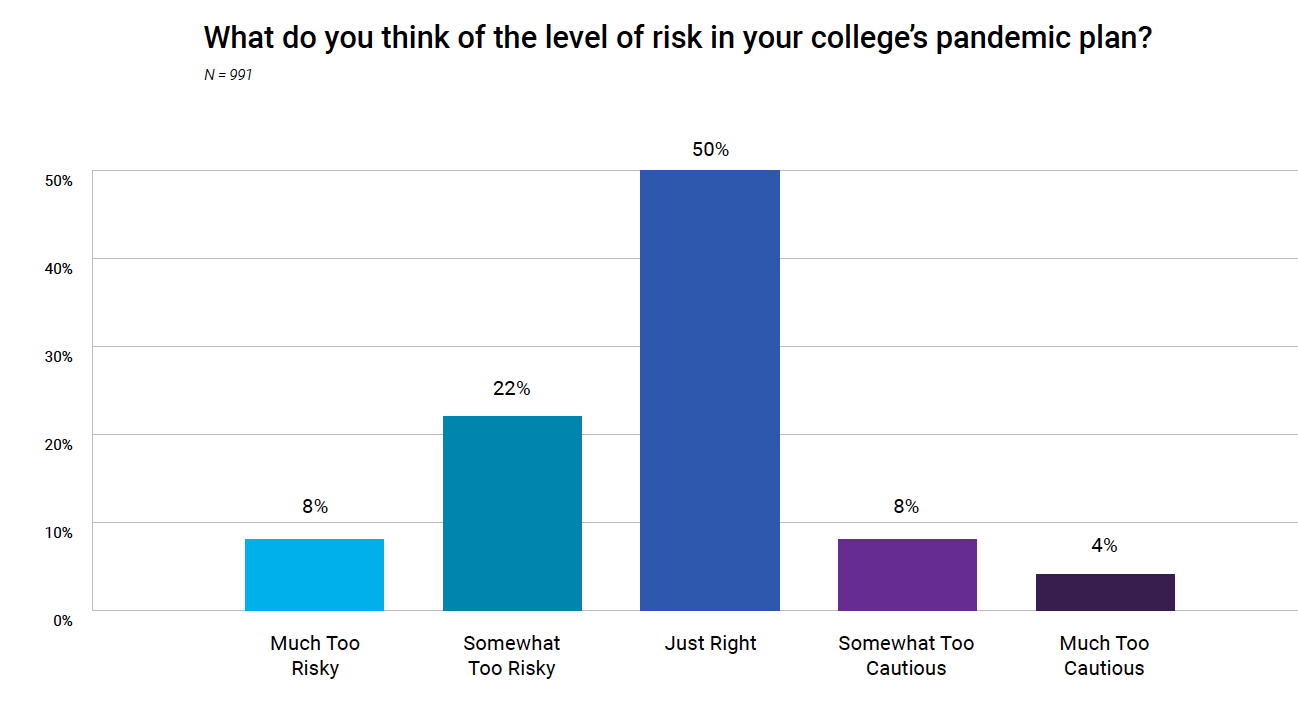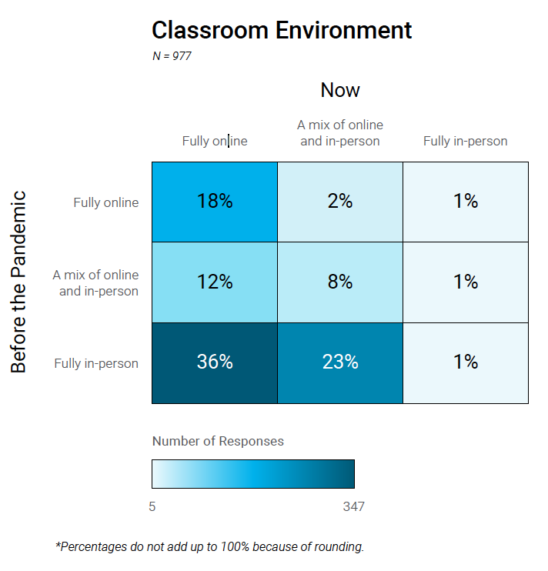
Lundqvist, A., Rice, A. and Widenhorn, M. (2020) The Pandemic College Student Experience:Implications for Student Success and Retention Anthology Inc., November
The ‘quick and dirty’ reports on the impact of Covid-19 emergency responses at universities and colleges in the USA are now coming thick and fast.
This report looks at the more general impact of the various arrangements made by colleges and universities on student sentiment regarding the ‘academic and co-curricular experience.’ This report is from Anthology Inc, a private consulting company that provides services to American colleges and universities. Anthology is an amalgamation of Campus Management, Campus Labs, and iModules.
This is a much more detailed study than the Top Hat study, and although I provide the main findings below, I strongly recommend you read the full report, available here.
Methodology
This was a ‘nationwide’ survey in October of 1,143 students, mainly in public (67%) four year institutions (78%) and mainly female (71%), and undergraduates (83%), presumably all in the USA.
Main results
- the study reported a significant shift if the way students are taking courses from pre-pandemic (see Figure 1 below). Before the pandemic, 70% of the sampled students were taking classes fully in person (on-campus) and 18% fully online (the rest were taking a mix). In October, only 3% were taking courses fully in person, 66% were taking courses fully online, and 33% were taking a mix.

Figure 1: Changes to mode of delivery
- satisfaction is lower currently than how respondents rated their satisfaction prior to the start of the pandemic across three areas (academic courses, communications, and student services), as well as for the institution overall. About one-third of students expressed being dissatisfied currently in each of these four areas, compared to between 12 percent and 16 percent before the pandemic, indicating a roughly 20 percent decrease in satisfaction. However, note that two-thirds expressed that they were still somewhat or very satisfied with all four areas in October.
- responses to more qualitative aspects of a campus experience, such as social life and support from the college, showed that 15-25% of students felt these were missing, but again, the majority of students were positive about these aspects. Nevertheless, the report concluded that ‘Institutions need to find ways to increase and improve social support, particularly in the virtual environment.’
- the 54 percent of students who experienced a change in their educational environment during the term (e.g., shifting from in-person to online classes) shows both lower satisfaction rates and lower student success outcomes
- About nine in 10 students indicated a likelihood to re-enroll at the same college for the next term, with a majority (62 percent) indicating that they “definitely will” re-enroll
- more than half (68 percent) of students indicated they were concerned with their ability to pay for their education, with that concern more often reported by first-generation students and non-white students
- Overall, half of the student respondents indicated that the level of risk in their college’s current pandemic plan was “just right.” However, more students indicated it was too risky as compared to too cautious. The students who found the plan to be “just right” reported higher satisfaction, were more likely to re-enroll and were more likely to report feelings of safety.
Recommendations
The report makes a number of useful recommendations for institutions, the main one being the need to pay more attention to the need for virtual students to belong to a community, even if virtually, and the need to strengthen students’ connection with their institution while they are studying remotely.
It also has an interesting set of reflexions that are well worth reading.
My comments
Although the sample size is again pitifully small, it does look roughly representative of the student higher education population in the USA. Second it is focused entirely on the USA, where the effects of the pandemic have been particularly bad.
Again, this is a sort of ‘half-empty, half-full’ report. Clearly the move to virtual learning, and the fear created by the pandemic, have inevitably had some bad outcomes for students. Interestingly though these are understandably more in the affective areas of ‘belonging’, social engagement, than as far as can be assessed at this time, in the academic performance area. Students by and large remain positive about their institutions and their studies, despite the difficulties caused by the institutions’ responses to Covid-19.
In short, the higher education system has been dealt a terrible challenge but the system has not collapsed and students are managing to continue successfully their studies, even though the circumstances are not what they would prefer.









 Dr. Tony Bates is the author of eleven books in the field of online learning and distance education. He has provided consulting services specializing in training in the planning and management of online learning and distance education, working with over 40 organizations in 25 countries. Tony is a Research Associate with Contact North | Contact Nord, Ontario’s Distance Education & Training Network.
Dr. Tony Bates is the author of eleven books in the field of online learning and distance education. He has provided consulting services specializing in training in the planning and management of online learning and distance education, working with over 40 organizations in 25 countries. Tony is a Research Associate with Contact North | Contact Nord, Ontario’s Distance Education & Training Network.

